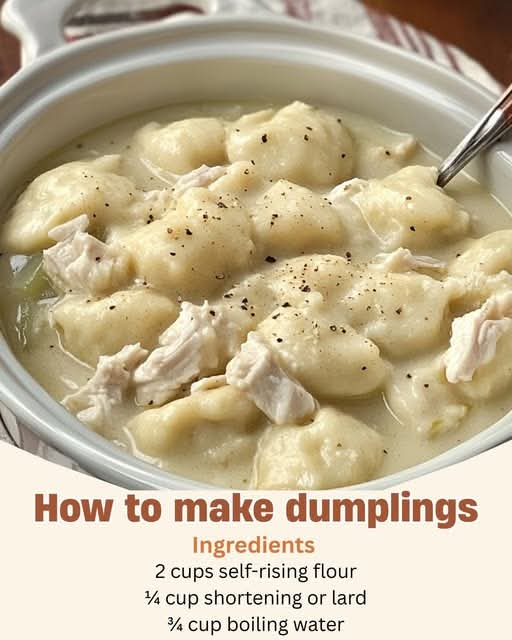Introduction
Southern dumplings are the hallmark of soul-soothing comfort food. These tender, slightly chewy strips of dough are simmered in rich, flavorful broth, soaking up all that savory goodness. They’re the kind of food that feels like a warm hug — perfect for cozy family dinners or chilly evenings. Unlike the fluffy drop dumplings more common in Northern cooking, Southern dumplings are rolled and cut into thick noodles or squares, then gently cooked in simmering liquid until pillowy and perfect.
Whether served with classic chicken and dumplings, stews, or hearty vegetable broth, these dumplings bring home that Southern charm. Let’s walk through how to make these humble, hearty gems from scratch.
Ingredients
| Ingredient | Amount | Notes |
|---|---|---|
| All-purpose flour | 2 cups | Use plain flour for structure |
| Baking powder | ½ teaspoon | Adds a subtle lift to the dough |
| Salt | ½ teaspoon | Enhances overall flavor |
| Shortening / Butter / Lard | 2 tablespoons | Lard gives traditional flavor; butter is fine too |
| Milk or Buttermilk | ¾ cup | Buttermilk adds a Southern tang |
Instructions
1. Mix the Dry Ingredients
In a large mixing bowl, whisk together:
- 2 cups all-purpose flour
- ½ tsp baking powder
- ½ tsp salt
These three form the base of your dumpling dough. The baking powder helps provide a gentle rise, while the salt balances the flavors.
2. Cut in the Fat
Add 2 tablespoons of shortening, butter, or lard to the dry ingredients. Using a pastry cutter, fork, or your fingertips, cut the fat into the flour mixture until it resembles coarse crumbs. This step is essential for creating tender dumplings with a slightly flaky texture.
3. Add the Liquid
Pour in ¾ cup of milk (or buttermilk if you like a tangier flavor). Stir gently with a wooden spoon or spatula until a soft, shaggy dough forms. It shouldn’t be too wet or sticky — just enough moisture to hold together.
Tip: If your dough feels too dry, add 1–2 tablespoons more milk.
4. Roll and Cut
Transfer the dough onto a floured surface. Lightly flour the top and your rolling pin, then roll out the dough to about ¼ inch thick. Thicker dumplings will be chewier and more rustic, which is traditional for Southern cooking.
Use a knife or a pizza cutter to slice the dough into 1″ x 2″ strips or squares. You can also do rustic shapes — they don’t need to be perfect!
5. Simmer in Broth
Bring a pot of chicken broth, vegetable broth, or homemade stew to a gentle simmer. Slowly drop the dumplings into the broth one at a time, stirring occasionally to prevent them from sticking together.
Simmer uncovered for 15–20 minutes, or until dumplings are cooked through and slightly puffy. They’ll thicken the broth as they cook, creating a rich and silky base.
Serving Suggestions
Southern dumplings shine best in dishes like:
-
Classic Chicken and Dumplings
Add cooked, shredded chicken and a mirepoix of carrots, celery, and onions to the broth for a timeless comfort meal. -
Vegetable Stew with Dumplings
A great vegetarian option: load up the broth with sweet potatoes, mushrooms, peas, and leeks. -
Creamy Turkey Dumplings
Use leftover Thanksgiving turkey and a splash of cream in the broth for a luxurious take.
Tips for Perfect Southern Dumplings
-
Don’t Overwork the Dough
Stir just until combined. Overmixing can lead to tough dumplings. -
Use Buttermilk for Extra Southern Flavor
Buttermilk adds a subtle tang and extra tenderness. -
Simmer, Don’t Boil
A rolling boil can break apart your dumplings. Keep it at a gentle simmer. -
Flavor the Broth
Add bay leaves, fresh herbs, and garlic to your broth for an aromatic base that complements the dumplings. -
Let Them Rest
After cooking, let the dumplings sit in the broth off the heat for 5–10 minutes. They’ll soak up even more flavor.
Frequently Asked Questions (FAQs)
1. Can I make these dumplings ahead of time?
Yes! You can prepare and cut the dough up to 1 day in advance. Store it wrapped tightly in plastic wrap and refrigerate until ready to cook. You can also freeze uncooked dumplings for up to 1 month.
2. Why are my dumplings falling apart?
Your broth may be boiling too aggressively, or the dough may have too little flour or too much liquid. Simmer gently and measure accurately.
3. Can I use self-rising flour instead of all-purpose?
Yes — just omit the baking powder and salt if using self-rising flour.
4. Are Southern dumplings the same as noodles?
Not exactly. Southern dumplings are thicker and softer than noodles, though both are cut from rolled dough. Dumplings are more pillowy, while noodles are thinner and chewier.
5. Can I make these dumplings gluten-free?
Yes. Use a 1:1 gluten-free flour blend and ensure your baking powder is gluten-free. Keep in mind the texture may be slightly different.
6. What’s the best broth for these dumplings?
A rich chicken broth made with aromatics (onions, carrots, celery, bay leaves) works beautifully. However, any flavorful broth will work.
Conclusion
Southern dumplings are proof that some of the best recipes come from simple, wholesome ingredients and old-fashioned techniques. These rolled, simmered dumplings are hearty, humble, and absolutely soul-satisfying. Once you’ve mastered this basic dough, the possibilities are endless — serve them with meats, stews, veggies, or just in a flavorful homemade broth. Whether it’s your first time making them or your hundredth, Southern dumplings always hit the spot.
So roll up your sleeves, dust your counter with flour, and bring a little taste of the South into your kitchen today!

